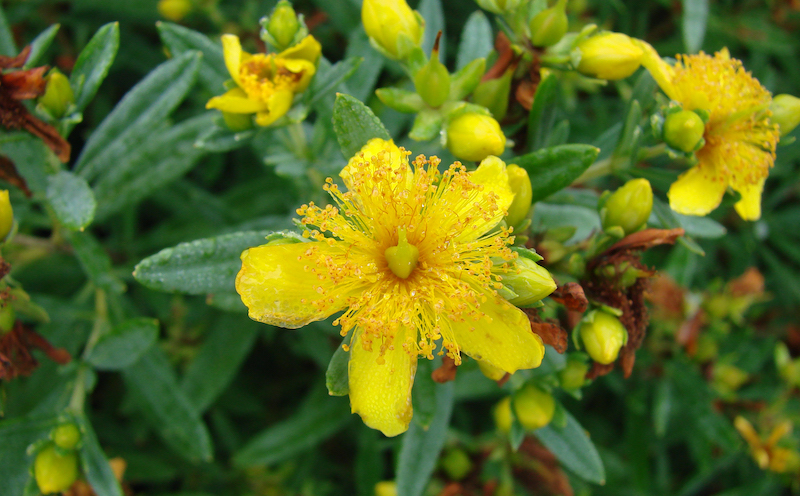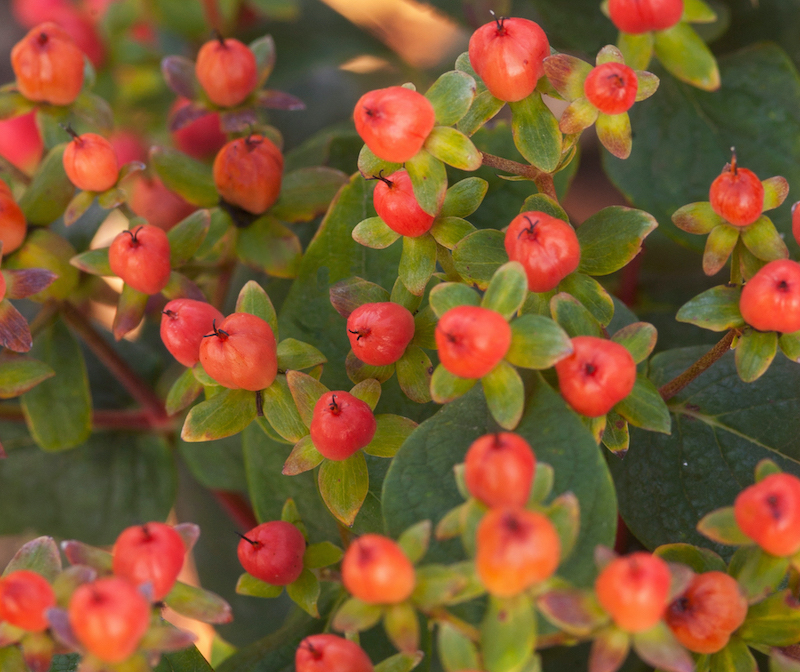St John’s Wort makes a very attractive container plant. The interesting foliage, long-lived flowers, and berries that last throughout the winter months give this shrub four wonderful seasons of interest. The mature height for St. John’s Wort ranges from 10 inches to over 6 feet. The larger cultivars work well as a single element in a decorative pot.
The smaller varieties combine nicely in a mixed seasonal planting for a front entrance, patio, or deck. Adding other perennials such as Golden Sedge and Rudbeckia creates a great summer blooming mix that will easily transition to the winter just by adding a fall-blooming Pansies. St John’s Wort can be a bit of an aggressive grower, so growing this shrub in pots will keep its spread under control.

Planting St John’s Wort in Pots
St John’s Wort is a hardy shrub and able to be planted in containers almost any time of the year. Early spring or late summer is when the plants are typically available in nurseries. Planting in early spring will allow the root system to establish over the summer before the fall dormancy period starts. A location in full sun or partial shade is ideal and will encourage heavier blooming, which in turn ensures heavy berry production for the fall and winter.
The size of the container depends on if you will be growing St. John’s Wort as a single specimen or as part of a mixed planter. St. John’s Wort will happily grow in a medium-sized container for a long time without needing to be repotted. Pots need to be at least 12 inches in diameter and have excellent drainage in the bottom. Porous terracotta pots will dry out faster in hot dry weather than plastic or resin composite containers. Terracotta is also less resistant to cold weather and may crack, flake, or break.

Best Soil For St. John’s Wort in Pots
All-purpose potting soil is the best medium for planting St. John’s Wort in a container. Look for a brand that uses a peat-free mix. The soil can have added fertilizers or not. Soils with added fertilizers will still need supplemental feeding, although not for the first 3-4 weeks. Products that have the OMRI (Organic Materials Research Institute) seal are considered organic and suitable for organic plant production under USDA rules. Using mulch on the top of the potting soil has all of the same benefits as mulching in a garden bed. The soil will stay cooler, and damper, and if the mulch is an organic material, it will help to feed the soil.
Caring For St John's Wort in Planters
Shrubs growing in planters will need more looking after than the same shrubs growing in the ground. The gardener needs to supply any moisture or food that the shrubs need to remain vigorous growers. Shrubs that often do not need supplemental fertilizer in the ground will require regular feeding throughout the growing season when grown in a container.
Watering St. John’s Wort in Pots
Container-grown St. John’s Wort will require watering on a regular basis. When the top 2 inches of soil are dry, it is time to thoroughly saturate the soil. Water until it runs out of the drainage holes. If the pots have completely dried out, they need to be rehydrated by soaking the container several times. Move the container to a shady spot to allow the plant to recover, if possible. Within a few hours, the plant should start to perk up and the soil should still be damp to the touch.
Fertilizing St. John’s Wort in Pots
St. John’s Wort will stay healthy and robust when it is fed a slow-release fertilizer on a regular basis throughout the growing season. A diluted liquid fertilizer is easiest to use, once a month, in place of a watering session. A formulation that is intended for heavy blooming plants will support both flowering and berry formation. Look for a low concentration of Nitrogen (N) and higher Phosphorus (P) and Potassium (K) content.
Fox Farms Big bloom and Espoma liquid Bloom! fertilizers both have low enough levels of Nitrogen to encourage healthy foliage growth and color while maintaining the blooming of St. John’s Wort. Once a month feeding should continue through the summer and end by the middle or end of August in most growing zones. The shrubs need to prepare for fall dormancy, and feeding late in the season interrupts that process.
Winter Care For St. John’s Wort in Pots
Winter protection for St. John’s Wort is rarely needed when it is planted in the ground. The shrubs growing in containers will benefit from a bit more care in the colder growing zones of 4 and 5, where the temperatures can dip low and snow can be heavy at times. A plastic or resin pot will have less chance of breaking in these colder zones and also provides a bit more insulation for the plant's roots. Wrapping the pot in burlap or horticultural fabric will also insulate the soil and root zone from extreme temperature changes.
Watering only needs to be monitored until the first freeze of the fall. After that, the roots should be dormant enough to get by on natural precipitation. If you garden in an area that gets heavy rains in the winter, make sure the pots are not affected by runoff from roofs or downspouts, and that the pots do not sit in standing water. Waterlogged soil will kill St. John’s Wort over the winter.
Growing St. John’s Wort Indoors
St. John’s Wort does not need to be brought indoors for the winter in zones 4-9. If you are gardening in a lower zone, the shrub can be treated as a houseplant for the winter. Choose e spot with bright, indirect light, away from sources of dry air like radiators or furnace vents. The smallest of the cultivars like ‘Red Flame’ or ‘Pumpkins’ have fabulous, long-lasting berries that are a nice addition to decor during the winter holidays.
 |
Author Robbin Small - Published 8-15-2022 |
